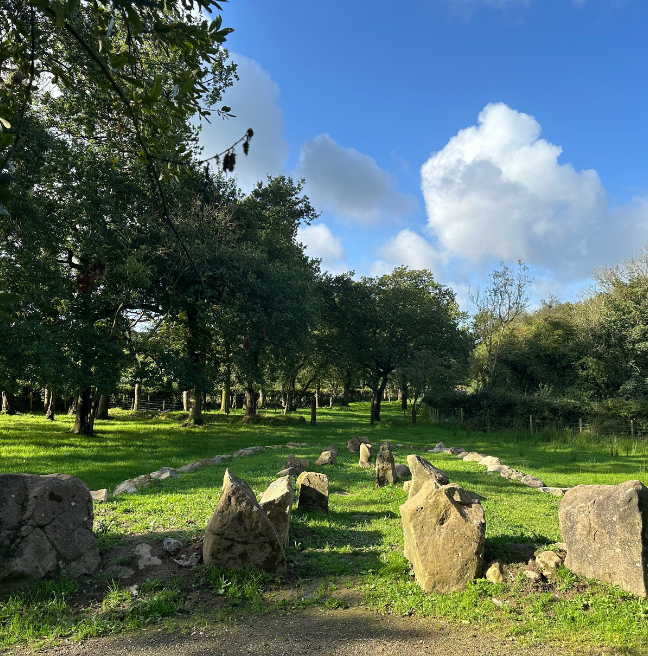
The Neolithic Past of Ulster
Learn about court tombs and the Neolithic period from Dr Greer Ramsey, Curator of Archaeology.
A Brief History
If you’ve been to the Ulster Folk Museum before, you’ll know that we have a number of buildings that were reconstructed from both the urban and rural landscape. But one of the most interesting and unusual projects was re-erecting a court tomb that was first built some six thousand years ago at Ballintaggart in Co. Armagh.
In 1966, the area was threatened by a quarry expansion and the site was excavated by the former Keeper of Antiquities at the Ulster Museum, Laurence Flanagan. Most of the finds that were recovered were pottery and flints, because it had been disturbed at an earlier period. Flanagan reconstructed the tomb outside the Ulster Museum and there it sat for a number of years until the Ulster Museum was renovated. The stones were removed to storage at the Ulster Folk Museum. After a period of consultation, we developed a project to reinstate the tomb as it would have looked at the time it was excavated.

Setting the context
If you imagine standing at the highest point of the Ulster Folk Museum during the period of the Mesolithic, about ten thousand years ago, and looking down towards Belfast Lough, the first thing you would notice is that the landscape is heavily wooded. People had minimal impact on the landscape due to a low population density. Going forward about four thousand years, you would begin to notice a change coming about due to the advent of agriculture in Ireland. New people were physically moving into the landscape, bringing with them arable crops and domestic animals, including cattle and sheep. These new populations would have had to clear the wooded landscape for places to plant crops and keep animals. They did so by using Neolithic polished axes – some of which are on display at the Ulster Museum in the Early Peoples Gallery. This marks the beginning of a period of deforestation, which had been minimal initially and began to accelerate through time.

Neolithic pottery
Along with tools like stone axes, pottery was also a new arrival to Ireland during the Neolithic. One of the finds that came from the court tomb was a range of pots. At the time of excavation, many were found broken and subsequently reconstructed and are also on display at the Ulster Museum.
You may ask the question: what were people cooking in the pots? Was it Irish stew or more of a breakfast muesli? We can actually tell the difference by analysing the fats, or lipids, which adhere to the inside of the pots. Studies have shown that the lipids from these pots have a high dairy signature, which means that they were being used for milk-based products. Due to this consumption of lactose-products, people with Irish ancestry are less likely to be lactose intolerant than people from areas where less or no dairy products were consumed.

Social change
The changes to the landscape coincided with social change. Such change was probably stimulated by the fact that for the first time, people could live in one place, so it would have been worth investing in building larger, more permanent structures. Some of the larger structures that began to populate the landscape were a range of tombs.
Megalithic tombs – meaning large stone tombs – are divided into a number of types. The Ballintaggart Court tomb is called a court tomb because the entrance to the burial chambers is marked by semi-circular upright stones. In the past, these tombs were sometimes referred to as ‘lobster cairns’ or ‘horned cairns’ due to the shape these stones made. The word ‘cairn’ is important because it reminds us that the burial chambers themselves were at one time covered in a mound of stones, but quite often these stones were removed through time. In the reconstruction of the Ballintaggart Court tomb, the mound hasn’t been replaced, so we can see physically into the tomb.
If you had witnessed the court tomb being reconstructed at the Ulster Folk Museum, you would have seen people with hard hats, jackets, and machinery at work – but the people of the past had no such equipment. Constructing the tomb would have involved a high degree of communal effort, but not everybody was going to be buried in these tombs.
In many ways the Ulster Folk Museum is the ideal place for the Ballintaggart Court tomb as it acts as a chronological starting point in our journey towards agriculture, which you can see throughout the site.

EXPLORE MORE
GráNite at the Ulster Folk Museum
Celebrate old stones and the history and folklore that surrounds them
Ballintaggart Court Tomb
A Neolithic tomb from Ballintaggart, Co. Armagh, has arrived at the Ulster Folk Museum.
The Giants' Graves of W. A. Green
As the Ballintaggart Court tomb arrives at the Ulster Folk Museum, we explore how the people of Ulster viewed archaeological monuments in the landscape.

